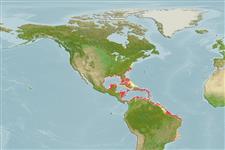>
Scombriformes (Mackerels) >
Scombridae (Mackerels, tunas, bonitos) > Scombrinae
Etymology: Scomberomorus: Latin, scomber = mackerel + Greek, moros = silly, stupid (Ref. 45335).
More on author: Bloch.
Environment: milieu / climate zone / depth range / distribution range
ນິເວດວິທະຍາ
ສັດທະເລ ກ່ຽວກັນຫີນ; ປາທີ່ມີການເຄື່ອນຍ້າຍໃນສະເພາະມາະຫາສະມຸດ (Ref. 51243); ລະດັບຄວາມເລິກ 1 - 20 m (Ref. 9710), usually 1 - ? m (Ref. 55288). Tropical; 41°N - 24°S, 99°W - 34°W
Western Atlantic: Massachusetts, USA to Brazil, including the Bahamas and West Indies.
Length at first maturity / ຂະໜາດ / ນ້ຳໜັກ / Age
Maturity: Lm 40.5, range 38 - ? cm
Max length : 183 cm TL ຕົວຜູ້/ບໍ່ມີເພດ; (Ref. 26340); ນ້ຳໜັກສູງສຸດທີ່ເຄຍຈັດພີມມາ: 7.8 kg (Ref. 4699)
ຄີ (ໜາມ)ແຂງຢູ່ຫຼັງປາ (ທັງໝົດ) : 16 - 18; ຄີຫຼັງຂອງປາ (ຄີອ່ອນ) (ທັງໝົດ) : 15 - 19; ຄີ(ໜາມ) ແຂງຢູ່ຄີກົ້ນປາ
ກຸ່ມປາກະດູກແຂງ
ຄວາມຖີ່ຂອງກຸ່ມຖ່າຍທອດພັນ
ປາທີ່ມີການເຄື່ອນຍ້າຍຈາກທະເລໄປຫານ້ຳຈືດ ແລະນ້ຳຈືດຫາທະເລ
ປາທີ່ມີການເຄື່ອນຍ້າຍຈາກທະເລແລະໄປໄຂ່ຢູ່ນ້ຳຈືດ
ຄີກົ້ນຂອງປາ
ສັດທີ່ມີກະດູກສັນຫັຼງ
ການຖ່າຍທອດທາງກຳມະພັນຈາກພໍ່ແມ່ຫາລູກ: 0; ຄີກົ້ນຂອງປາ: 15 - 20; ສັດທີ່ມີກະດູກສັນຫຼັງ: 47 - 48. Interpelvic process small and bifid. Lateral line gently curving down toward caudal peduncle. Intestine with 2 folds and 3 limbs. Swim bladder absent. Body covered with small scales. Anterior third of first dorsal fin black. Pelvic fins relatively long. Sides silvery with one long mid-lateral stripe and with several rows of yellow-orange streaks of variable length and small yellow spots above and below the stripe.
Most abundant in clear waters around coral reefs, occasionally forming schools. Feeds on clupeoids (Harengula, Jenkinsia and Opisthonema) and atherinids (Allanetta [= Craterocephalus), squids and shrimps. Good food and game fish (Ref. 5521). Utilized fresh, smoked and frozen; consumed pan-fried, broiled and baked (Ref. 9987). Sometimes called the "Painted Mackerel" (Ref. 13442).
Collette, B.B. and C.E. Nauen, 1983. FAO Species Catalogue. Vol. 2. Scombrids of the world. An annotated and illustrated catalogue of tunas, mackerels, bonitos and related species known to date. Rome: FAO. FAO Fish. Synop. 125(2):137 p. (Ref. 168)
IUCN Red List Status (Ref. 130435: Version 2024-1)
Threat to humans
Reports of ciguatera poisoning (Ref. 9987)
Human uses
ການປະມົງ: ທີ່ເປັນການຄ້າໜ້ອຍ; ຊະນິດປາທີ່ຖືກນຳໃຊ້ເຂົ້າໃນການຫາເພື່ອເປັນເກມກິລາ: ແມ່ນ
ເຄື່ອງມື
Special reports
Download XML
ແຫຼ່ງອີນເຕີເນັດ
Estimates based on models
Preferred temperature (Ref.
123201): 23.4 - 28.1, mean 27.3 °C (based on 977 cells).
Phylogenetic diversity index (Ref.
82804): PD
50 = 0.5000 [Uniqueness, from 0.5 = low to 2.0 = high].
Bayesian length-weight: a=0.00977 (0.00522 - 0.01830), b=3.01 (2.85 - 3.17), in cm total length, based on LWR estimates for this species & Genus-body shape (Ref.
93245).
ຊັ້ນເຂດຮ້ອນ (Ref.
69278): 4.5 ±0.4 se; based on diet studies.
ຄວາມຢືດຢຸ່ນ (Ref.
120179): ຂະໜາດກາງ, ປະຊາກອນຕຳ່ສຸດທີ່ໃຊ້ເວລາສອງເທົ່າ 1.4 - 4.4 ປີ (Fec=160,000; assuming tm=2-4).
Prior r = 0.37, 95% CL = 0.25 - 0.56, Based on 1 data-limited stock assessment.
Fishing Vulnerability (Ref.
59153): Very high vulnerability (90 of 100).
Climate Vulnerability (Ref.
125649): High vulnerability (57 of 100).
Nutrients (Ref.
124155): Calcium = 8.08 [3.23, 27.36] mg/100g; Iron = 0.327 [0.126, 0.834] mg/100g; Protein = 21.2 [19.7, 22.7] %; Omega3 = 0.113 [0.070, 0.193] g/100g; Selenium = 39.6 [12.7, 130.5] μg/100g; VitaminA = 66.6 [12.9, 341.5] μg/100g; Zinc = 0.541 [0.330, 0.918] mg/100g (wet weight);
